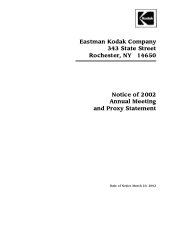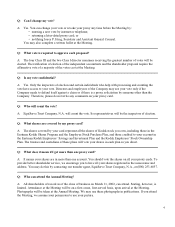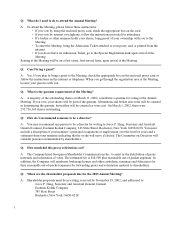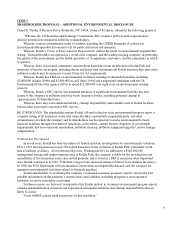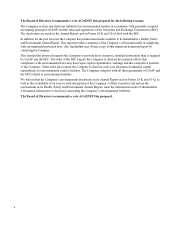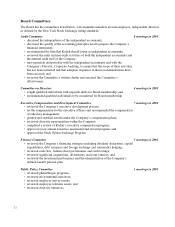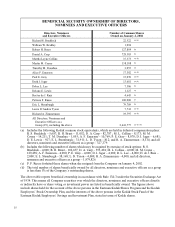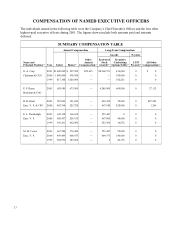Kodak 2001 Annual Report Download - page 95
Download and view the complete annual report
Please find page 95 of the 2001 Kodak annual report below. You can navigate through the pages in the report by either clicking on the pages listed below, or by using the keyword search tool below to find specific information within the annual report.
ITEM 3
SHAREHOLDER PROPOSAL—ADDITIONAL ENVIRONMENTAL DISCLOSURE
Daniel E. Naulin, 8 Baymon Drive, Rochester, NY 14624, owner of 82 shares, submitted the following proposal:
“Whereas, the US Securities and Exchange Commission (SEC) requires publicly-held corporations to
disclose potential environmental liabilities to shareholders;
Whereas, various environmental codes of conduct, including the CERES Principles (Coalition for
Environmental Responsible Economies) call for public disclosure and openness;
Whereas, Kodak’s Vision of Environmental Responsibility affirms the intent of environmental responsibility
stating: ‘Eastman Kodak is recognized as a world-class company, and the leading imaging company, in protecting
the quality of the environment and the health and safety of its employees, customers, and the community in which
it operates;’
Whereas, there is increased community concern about hazardous waste incineration at Kodak Park and
emissions of known carcinogens, including dioxin and hexavalent chromium and Kodak acknowledges that costly
pollution controls may be necessary to meet Clean Air Act requirements;
Whereas, Kodak has a history of environmental violations resulting in substantial penalties including
$2,000,000 in fines (1990) and $5,000,000 in civil fines (1994) and a negotiated settlement with the US
Environmental Protection Agency (EPA) to spend $12,000,000 over eight years on environmental cleanup
projects;
Whereas, Kodak’s SEC reports, lists potential instances of significant environmental liability that may
accrue to the company in pollution and toxic waste cleanup activities, including potential cleanup at
‘approximately 20 Superfund sites;’
Whereas, there may exist additional liability, cleanup responsibility and remedial costs at Kodak facilities
beyond what is presently reported in SEC reports;
BE IT RESOLVED: The shareholders request Kodak’s Board to disclose in its environmental progress report, a
complete listing of all hazardous waste sites where Kodak is a potentially responsible party, and other
circumstances in which the company and its shareholders can be expected to accrue environmentally-based
financial liabilities through retirement of operations, court orders, consent decrees, litigation, or government
requirements, that environmental remediation, pollution clean-up, pollution equipment upgrades, and/or damage
compensation.
S
UPPORTING
S
TATEMENT
In recent years, Kodak has been the subject of federal and state investigations for environmental violations.
EPA’s 1991 investigation uncovered 150 federal hazardous waste violations at Kodak Park ‘potentially worth
tens of millions of dollars.’ (Environmental Reporter, Washington DC). In addition to a $100,000,000
underground storage tank improvement project at Kodak Park, the company is liable for the investigation and
remediation of five hazardous waste sites on that property, and is listed as a PRP at numerous other Superfund
sites. Kodak continues to be New York State’s largest toxic chemical releaser (Federal Toxic Release Inventory).
In 1998, the NYS Department of Environmental Conservation investigated Kodak and cited the company for
numerous environmental violations subject to financial penalties.
Kodak shareholders, in evaluating the company’s continued economic prospects, need to receive the best
possible information on the company’s current assets and liabilities, including prospective environmental
liabilities, as can be reasonably ascertained.
For these reasons, we believe it is imperative that Kodak include in its annual environmental progress report,
a listing and identification of known and expected environmental liabilities and cleanup responsibilities that are
likely to accrue.
If you AGREE, please mark your proxy for this resolution.”
8




